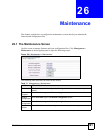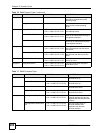
Chapter 27 Access Control
ES-2024 Series User’s Guide
198
27.3 About SNMP
Simple Network Management Protocol (SNMP) is an application layer protocol used to
manage and monitor TCP/IP-based devices. SNMP is used to exchange management
information between the network management system (NMS) and a network element (NE). A
manager station can manage and monitor the Switch through the network via SNMP version
one (SNMPv1), SNMP version 2c or SNMP version 3. The next figure illustrates an SNMP
management operation. SNMP is only available if TCP/IP is configured.
Figure 113 SNMP Management Model
An SNMP managed network consists of two main components: agents and a manager.
An agent is a management software module that resides in a managed Switch (the Switch). An
agent translates the local management information from the managed Switch into a form
compatible with SNMP. The manager is the console through which network administrators
perform network management functions. It executes applications that control and monitor
managed devices.
The managed devices contain object variables/managed objects that define each piece of
information to be collected about a Switch. Examples of variables include number of packets
received, node port status and so on. A Management Information Base (MIB) is a collection of
managed objects. SNMP allows a manager and agents to communicate for the purpose of
accessing these objects.
SNMP itself is a simple request/response protocol based on the manager/agent model. The
manager issues a request and the agent returns responses using the following protocol
operations:
Table 75 SNMP Commands
COMMAND DESCRIPTION
Get Allows the manager to retrieve an object variable from the agent.
GetNext Allows the manager to retrieve the next object variable from a table or list within an
agent. In SNMPv1, when a manager wants to retrieve all elements of a table from an
agent, it initiates a Get operation, followed by a series of GetNext operations.
Set Allows the manager to set values for object variables within an agent.
Trap Used by the agent to inform the manager of some events.


















